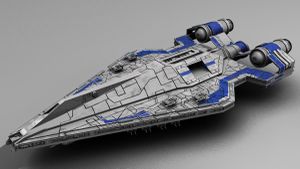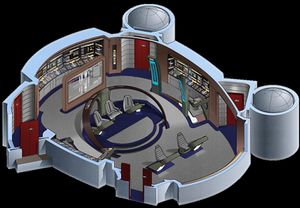No edit summary |
(→Combat) |
||
| (One intermediate revision by the same user not shown) | |||
| Line 1: | Line 1: | ||
[[File:{{#setmainimage:widow-maker-class.jpg}}|thumb]] | [[File:{{#setmainimage:widow-maker-class.jpg}}|thumb]] | ||
[[File:widow-maker-bridge.jpg|thumb|Bridge Module]] | [[File:widow-maker-bridge.jpg|thumb|Bridge Module]] | ||
The Widow Maker Class is the latest design in [[Solas Tempus]] technologies. It fuses together concepts from common elements from Federation, Romulan, and Klingon designs with those of Imperial and Rebel Alliance designs brought in by [[Splicers]] who were brought to this universe unintentionally by a [[Splice]]. The new design elements feature the shape and general design trajectory and philosophy of the vessel away from the standard hull designs prevalent in Federation / Solas Tempus vessels. The wedge shape and the feature of extremely powerful engines as well as a throw-back to terrestrial Earth ship designs from Frigates and Battle Ships where mounted cannons were extensively used, as they are in Imperial vessels which have spliced in. | The Widow Maker Class is the latest design in [[Solas Tempus]] technologies. It fuses together concepts from common elements from Federation, Romulan, and Klingon designs with those of Imperial and Rebel Alliance designs brought in by [[Splicers]] who were brought to this universe unintentionally by a [[Splice]]. The new design elements feature the shape and general design trajectory and philosophy of the vessel away from the standard hull designs prevalent in Federation / Solas Tempus vessels. The wedge shape and the feature of extremely powerful engines as well as a throw-back to terrestrial Earth ship designs from Frigates and Battle Ships where mounted cannons were extensively used, as they are in Imperial vessels which have spliced in. Unlike traditional designs, the bridge in this case is located within the forward section of the hull to add better protection against attacks, its exterior is not exposed on the outer hull. | ||
; Length : 387 meters | ; Length : 387 meters | ||
| Line 58: | Line 58: | ||
This breaks down to a total compliment of combat space craft: | This breaks down to a total compliment of combat space craft: | ||
* [[Danube Class]] | * [[Danube Class Runabouts]] (5) | ||
* [[Venture Class Runabouts]] (2) | * [[Venture Class Runabouts]] (2) | ||
* [[Flyer Class Shuttles]] (2) | * [[Flyer Class Shuttles]] (2) | ||
Latest revision as of 17:06, 6 September 2018


The Widow Maker Class is the latest design in Solas Tempus technologies. It fuses together concepts from common elements from Federation, Romulan, and Klingon designs with those of Imperial and Rebel Alliance designs brought in by Splicers who were brought to this universe unintentionally by a Splice. The new design elements feature the shape and general design trajectory and philosophy of the vessel away from the standard hull designs prevalent in Federation / Solas Tempus vessels. The wedge shape and the feature of extremely powerful engines as well as a throw-back to terrestrial Earth ship designs from Frigates and Battle Ships where mounted cannons were extensively used, as they are in Imperial vessels which have spliced in. Unlike traditional designs, the bridge in this case is located within the forward section of the hull to add better protection against attacks, its exterior is not exposed on the outer hull.
- Length
- 387 meters
- Crew
- 225 Standard
30 Minimum
500 Evacuation Capacity - Power Source
- Matter/Antimatter Reactors (3)
Deuterium Fusion Reactors (18) - Propulsion
- Dimensional Fold Drive
Jump Point Generator
Impulse Drive - Cruising Speed
- Warp 7.67
- Maximum Speed
- Fold 12.975
- Emergency Speed
- Fold 14 for 30 Minutes
Advanced Remote Sensor System
The Window Maker Class is the first in the Solas Tempus vessels to use the new Teufel Probes system. The proves are launched in groups of between 5 and 20 with a standard deployment of 8, they act as remote eyes and ears for the space craft even while the craft is cloaked. Though it should be noted that while the probes are in operation the cloak is imperfect and it may be possible to detect the subspace signals as the ship grows near. Individual probes should not output enough power to make a meaningful detection of their signals, since the ship communicates with the probes directly, its subspace radio signature would be higher.
Offensive Systems
- Dual-Cannon Pulse Phaser Turrets (12)
- 4 Dorsal, 8 Ventral
- 180 Degree Lateral Arc / 90 Degree Vertical Arc
- Heavy Anti-Proton Cannons (2)
- Forward / Ventral
- 90 Degree Lateral Arc (Moves as a Pair)
- Torpedo Launchers (4)
- 2 Forward, 2 Aft
- Standard Load-Out of Transphasic Torpedoes
- Accepts Standard Torpedo Design
- Magnified Heavy Ion Cannon
- Mounted Forward
Magnified Heavy Ion Cannon
Using a design of Imperial and Alliance forces from their native universe, the ship has a massive forward mounted ion cannon. The cannon collects ion particle energy in a spheroid stasis containment field during a charge phase, when the energy reaches peek, the field drops in the direction of fire and the collected ion particle energy discharges in a massive 5-10 meter wide beam. This ion beam is designed for a singular purpose, the disable shields and vessels.
The ion cannon overloads power and shield systems by exposing those systems to an intense discharge of particle energy, the energy is relatively low-impact on physical matter but instead produces and intensely polarized charge within whatever it hits. This causes an immediate and intense electromagnetic disruption in the area of impact, the charge displacement is so large that once it comes into contact with a conductive surface / signal or power conduit the disruptive charge continues along that path disrupting power and connected systems in its wake.
This cannon requires at least 3 minutes to charge, but can be fed directly from the interior matter/antimatter reactor. The cannon has a maximum charge point of 5 minutes and 15 seconds before it must discharge or risk the energy backfiring and disabling the ships own power systems.
Defensive Systems
- Deflector Shields
- Phasing Cloak
- Ablative Hull Armor
- ESMS
Deflector Shields
While Imperial vessels tend to have a centralized shield generator the makes for an excellent target, this vessel uses the Federation style shield grid which allows for the shields to be segmented but is more difficult to target. While the ship has no main deflector dish for warp travel, the deflector grid itself is enhanced to provide that functionality while at warp.
Auxiliary Craft
The ship has a main hangar deck with two hangar doors (port and starboard) which can be opened together for high efficiency simultaneous launch and recovery of auxiliary craft and fighters.
Non-Combat
- Type 6 Shuttle Craft (4)
- Workbees (8)
- Danube Class Runabouts (2)
Combat
- Patrol Squadron (2)
- Long Range Interceptor Squadron (2)
- Heavy Assault Squadron (1)
This breaks down to a total compliment of combat space craft:
Power Distribution
The vessel takes on Klingon philosophies of system redundancy, especially following Borg encounters the Klingon vessel design is to keep going as long as possible with decentralized power distribution systems and redundancy. The Widow Maker Class power systems use this same philosophy. The 18 deuterium fusion reactors are placed throughout the vessel. Reactors are placed at each gun turret, at the main bridge, in each shuttle bay, and at the central rear impulse engine. Each reactor is linked into the primary, secondary, and tertiary power grids and can be isolated from sections of the grid. When the grid is fully isolated the ship can maintain power independently throughout vessel. The vessel is capable of withstanding significant hits with ion cannons before becoming inoperative so long as the power distribution system can be put into a lock-down state. Different segments of the ship are even designed to be able to use different power grids independently.
Rather than having a single Matter/Antimatter reactor powering the ship, there are three reactors. Each reactor is independently fed fuel using the same distributed deuterium storage as the fusion reactors, with the addition of antimatter storage pods at each of the three locations. The reactors are placed one in each of the two primary engines as well as a centralized reactor which is directly tied into the main super-heavy Ion cannon located on the ventral forward section of the hull. Each reactor can be further died into any of the three power grids from the section of the ship it resides in. In addition, the three reactors have dedicated emergency power conduits which are laid out to connect each reactor to each other in the event one or more reactors is inoperative, those systems can be fed power from one of the other reactors.
The vessel is designed so that is can maintain operational power for shields, weapons, navigation, communications, and FTL capability even if two out of the three reactors are inoperative.
Engineering / Control
The distributed nature of the ships systems means that while the ship has a main engineering section toward the rear-central area of the ships interior, there are two other secondary engineering compartments each located at one of the ships main warp nacelles. Each one can cross-connect to control the vessels power systems, but are normally used to manage and monitor their own systems and coordinated from main engineering.
At main engineering there is also the primary fuel storage for the vessel, while each reactor has a reserve in place at that location which can be run independently, they are all fed from the main fuel storage located at main engineering.
Propulsion Redundancy
The Widow Maker Class is designed for maximum operational capacity.
Sub-Light / Impulse
The vessel is equipped with three primary sub-light impulse drive cores. The central impulse drive is the primary drive and is directly fed from a series of fusion reactors at that location in the central aft section of the ship. In addition to this each of the warp nacelles at the rear of the ship have their own smaller impulse drive system fed by independent fusion reactors at each location. These impulse drives are normally kept in a stand-by ready but ultimately inactive status.
FTL / Warp
The ships primary FTL system is a Dimensional Fold Drive coupled with a standard Warp Drive system. Each warp nacelle is fed by its own Matter/Antimatter reactor in the nacelle itself and have their own smaller reserve fuel storage there as well. However, the bulk of the fuel for these reactors comes from the ships main body, the primary fuel storage located near main engineering. If the DFD / Warp Drive system is rendered inoperative for some reason the ship is equipped with a Jump Point Generator which will allow it to enter Hyperspace. The system will not engage, however, unless all warp plasma has been purged from the drive system, otherwise upon entering Hyperspace the ship would suffer severe damage.
OOC
This class design I found out is actually the Antarian Class Cruiser from Star Wars Exodus, for the purposes of the Blazing Umbra Setting, the design is a new design and is not a refit of an existing class, that is to say for Star Wars characters in Blazing Umbra, the Antarian Class Cruiser does not look or function like this. However, there are parallels to the design, which were come up with by discussion on Discord after posting the image from Pinterest. Discussion took place in the #web-feeds channel on September 3rd, 2018 at 5:04pm U.S. Eastern Time.
As an additional note, there is a distinction between Hyperspace in this context (as used in most of Blazing Umbra) and that of Hyperspace in a Star Wars context, this uses the Blazing Umbra / Babylon 5 version of Hyperrspace, not that of Star Wars.